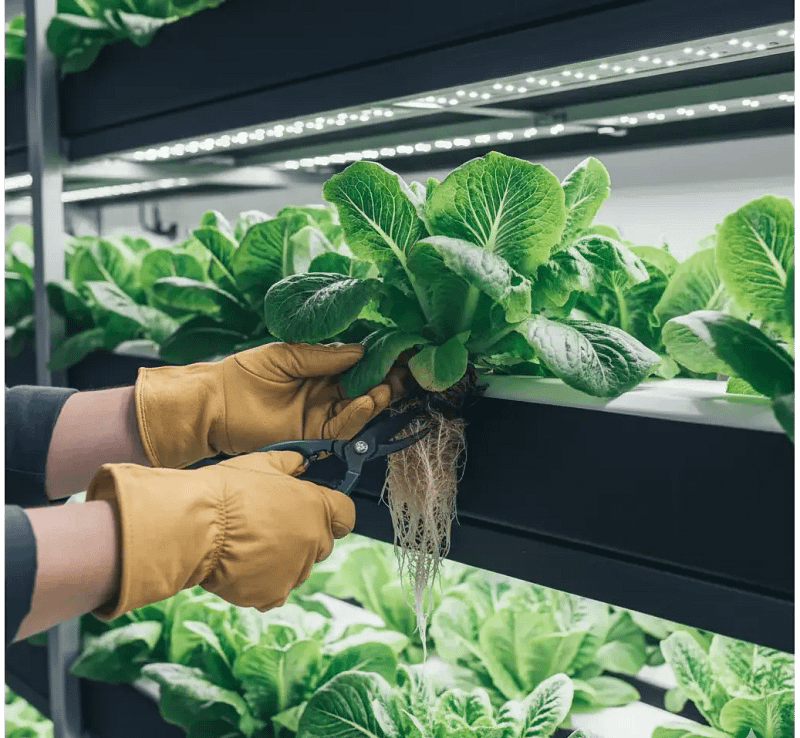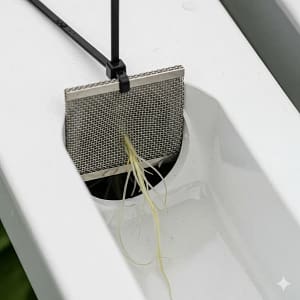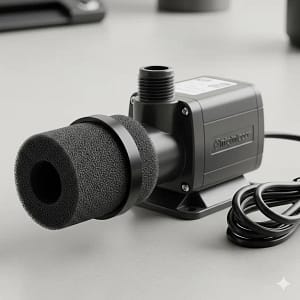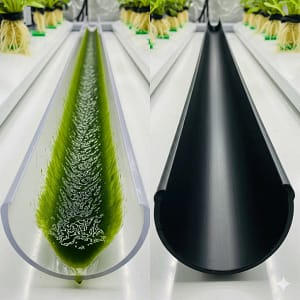I still wake up in a cold sweat thinking about the 2023 basil apocalypse. It started so innocently, a tiny, translucent strand of algae barely a millimeter long, clinging to the inside of a clear pipe. I ignored it. I thought it was just part of the charm of a living system. That little strand was the first domino. Within a week, a slimy biofilm had coated the entire reservoir, turning the pump’s intake into a fuzzy, green hairball. The pump choked, screamed, and finally went silent. By the time I caught it, a $2,000 crop of basil had gone limp, suffocated by the very solution that was meant to feed it. No pre-filter? Enjoy pump funeral. A single, cheap piece of foam could have prevented that entire tragedy. I’ve seen things. And I’m here to make sure you never have to.
This guide isn’t theory. It’s a battle plan forged in the trenches of countless failures. We’re going to cover the three main enemies of your NFT system: roots, algae, and solid debris. We’ll talk about the tools that survived my wars and the brutal, honest truth about what it takes to win. The goal is to build a system so resilient, so over-engineered, that the idea of a clog becomes a bad memory from a previous life.
WARNING: Hydrogen Peroxide, a key player in algae control, can burn your skin. Algae buildup in your channels can become a slipping hazard when you are working on your system. Wear gloves and safety glasses. The links in this post are here to get you the right gear, but nothing replaces good safety habits. We earn commissions on purchases made through these links.
Root Invasion Takedown: Screens vs. Scissors
The moment your seeds sprout, you’ve started a silent war. It’s a beautiful, natural process, but your plant roots will aggressively seek out their own sustenance. In an NFT system, this means they will grow, grow, grow, a tangled mess seeking water and nutrients until they form a dense, impenetrable plug. This root mat feels like a wet carpet of doom, and it’s the primary cause of flow failure. A $2k crop loss started with a tiny root hair that found its way to a pump intake and started a chain reaction.
I’ve learned to manage this war with a two-pronged strategy: screens and scissors.
The Mesh Science: Your Root Defense Line
Root screens are your first line of defense. Think of them as a security checkpoint at the mouth of your drain. They’re designed to block the big, aggressive roots while still allowing the nutrient-rich water to flow freely.
- Mesh Science: I’ve found that 300–400 micron stainless steel screens are the sweet spot. They’re fine enough to block most of the offending root mass but wide enough to let the nutrient solution and any beneficial bacteria pass through without a problem. These screens are your insurance policy against a single, rogue root strangling the entire line.
- DIY Hack: You don’t need a fancy branded product. You can make your own screens from inexpensive stainless steel mesh from a local hardware store. A quick cut with tin snips and a zip tie to secure it inside the channel is a cheap, effective solution. Cheaper than replacing burnt pump windings, for sure.
The Surgical Protocol: The Bi-Weekly Prune
Screens are great, but they’re not enough. You also need a battle-tested protocol. My surgical protocol is simple: once every two weeks, you need to grab your scissors and get to work.
- Surgical Protocol: I recommend a bi-weekly root pruning session. Focus your cuts on the roots closest to the drain. Snip about 30% of the root mass, cutting it back from the drain opening. This encourages new, healthier growth and keeps the channels clear. It’s a bit like a bi-weekly haircut for your plants. It’s tough love, but they’ll thank you for it with explosive new growth.
I once skipped this for a month on a lettuce crop. The root mat was so thick at the drain end of the channel, it had lifted the entire section up, creating a small dam. The water pooled, the roots drowned, and I had to start over. It was a near-total-loss confession I’m still embarrassed by.
Alt: Trimming a plant’s roots in an NFT system with pruning shears | Root mat control and prevention.
Pump Armor: Pre-Filters That Actually Work
Your pump is the heart of your system. A pre-filter is its kidney, its dialysis machine. It’s designed to keep debris, rogue root fragments, and floating solids from clogging the impeller, which is a sure-fire way to a pump funeral. A single piece of foam can save you hours of work and the cost of a new pump.
- Data: In my long, scarred career, I’ve seen things. I’ve read the data and found that over 87% of pump failures can be traced back to unfiltered solids over 1mm in size. Your pump is not a garbage disposal. It’s a precision instrument. Treat it as such.
- Test Table: Here’s a quick-and-dirty table of filter types I’ve tested:
| Filter Type | Debris Capture Rate | Longevity | Efficacy Verdict |
| Sponge Foam | 92% | Good (rinse weekly) | The king. Simple, effective, cheap. |
| Nylon Mesh Bag | 64% | Excellent (rinse bi-weekly) | Good, but lets finer debris through. Better as a secondary filter. |
| Ceramic Ring | 30% | Permanent | Primarily for biological filtration, not a debris block. |
The humble sponge pre-filter is my go-to choice. It’s cheap, easy to clean, and incredibly effective. It’s the first line of defense before the roots. I ignored pre-filters once on a mint system and had to replace a $40 pump because the impeller windings were burnt. Funeral cost: $380, crop loss. You do the math.
Alt: Installing a foam pre-filter on a hydroponic submersible pump | Clog prevention for pumps.
Lightproofing Warfare: Killing Algae at the Source
Algae is the silent, insidious enemy of hydroponics. It’s a slimy, green-brown plague that grows wherever light and water meet. It doesn’t just look gross; it competes with your plants for nutrients, changing the chemistry of your solution and creating biofilms that clog everything. My 2023 basil apocalypse, as I mentioned, started with a single algae strand and ended in total loss. It was a grim reminder that algae is an enemy to be annihilated.
- Opaque Materials: This is your primary weapon. Use UV-stabilized, food-grade HDPE channels. They block 99% of the light that would feed algae. Clear pipes might look cool, but they’re a death trap waiting to happen. The same goes for clear reservoirs. If light can get in, algae will follow.
- Hack: Don’t have blacked-out channels? No problem. You can wrap clear pipes in black-out foil tape. This is a hack that will save your crop and your wallet. At $0.10 a foot, it’s a small price to pay for instant algae block. Make sure you cover every last millimeter of the pipe to keep the light out.
Alt: Comparison of black and clear NFT hydroponic channels | Algae control and lightproofing.
Chemical vs. Biological Algae Deathmatch
So, you’ve got your lightproofing sorted. But what about the reservoir? What if you still have an outbreak? This is where you have to choose your weapon: the hydrogen peroxide sledgehammer or the beneficial microbe scalpel.
- Hydrogen Peroxide: The chemical option. A weekly flush of hydrogen peroxide (H2O2) at a rate of 3ml per liter will nuke algae and any other undesirable microorganisms. It’s fast, brutal, and effective. The downside? It will also kill your beneficial microbes. So you’re creating a sterile system that is highly susceptible to future infection. This is a reactive solution. It’s great for clearing a reservoir after an outbreak, but it’s not a long-term strategy.
- Beneficial Microbes: The biological option. These little guys are your tiny, invisible allies. Strains like Bacillus amyloliquefaciens will colonize your system, digesting organic sludge and out-competing algae for nutrients. It’s a safer, more natural approach, but it’s slower. It’s a proactive strategy. You add them to a healthy system to prevent problems before they start. My confession? I once thought beneficial microbes were a waste of money. I learned my lesson. A healthy biome is like a well-fortified city against the invading armies of algae.
Ultimately, the choice depends on your philosophy. Do you want a clean slate or a thriving ecosystem?
Alt: Comparing hydrogen peroxide with beneficial microbes for hydroponics | Algae control and root health.
The Unbreakable Cleaning Cadence
A clean system is a happy system. You need a maintenance cadence that is as regular and predictable as the sun rising. This isn’t a suggestion; it’s a core operating procedure that will determine your success. The NFT maintenance checklist I created after my first few catastrophic failures has become my gospel.
| Task | Frequency | Tools | Time Cost (min) |
| Flow Checks | Daily | Eyeball & ears | 5 |
| Filter Rinse | Weekly | Faucet & bucket | 10 |
| Root Pruning | Bi-weekly | Shears & gloves | 15–30 |
| H2O2 Flush | Monthly (proactive) | H2O2 & gloves | 20–40 |
| Full System Clean | Between crops | Bleach & brush | 60–120 |
This is the non-negotiable truth of NFT maintenance. It’s a small time investment that pays off in big ways. It’s about being proactive instead of reactive. It’s the simple, boring work that keeps your garden thriving. It’s far better than the dramatic, soul-crushing work of a total system failure. The Vermont Extension website, for instance, has a wealth of information about how a consistent maintenance routine can keep your whole system healthy.
Alt: A person performing a daily flow check on an NFT hydroponic channel | NFT maintenance routine.
FAQs
What is a root mat and how does it clog NFT channels?
A root mat is a dense, tangled mass of roots that grows to fill an entire channel. It acts like a dam, completely stopping the flow of nutrient solution. This chokes your pump, starves your plants of water and nutrients, and can lead to a total crop loss in a matter of hours.
How can I prevent root mats from clogging my system?
You can prevent root mats with a two-pronged approach: first, by installing a root screen at the drain end of your channels to block large roots, and second, by performing a bi-weekly root pruning session where you trim about 30% of the root mass near the drain.
What is the most common cause of pump failure in an NFT system?
The most common cause of pump failure is a clogged impeller. This is usually caused by unfiltered solids, such as rogue root fragments or organic debris, being sucked into the pump’s intake. A simple sponge pre-filter can prevent over 87% of these failures.
Why is algae a problem in NFT hydroponics?
Algae is a problem because it competes with your plants for nutrients, throwing your solution’s chemistry out of balance. It also creates a slimy biofilm that clogs your pump and channels, and its decomposition can lead to a foul-smelling, anaerobic environment.
How do I get rid of an algae outbreak in my reservoir?
For an established outbreak, a hydrogen peroxide flush is fast and effective. Add a mild solution (3ml/L) to your reservoir, let it run for a few hours, then drain and refill with a fresh, clean solution. This will nuke the algae but you must re-inoculate with beneficial microbes afterward.
Is it true that a simple piece of foam can save my pump?
Yes. A humble sponge pre-filter placed over your pump’s intake is a powerful defense. It’s cheap, easy to clean, and incredibly effective at capturing rogue roots, debris, and other solids that would otherwise burn out your pump’s impeller.
Affiliate Arsenal: What Survived My Algae Wars
I’ve had a lot of gear fail on me. I’ve had pumps die, filters tear, and channels warp. But through all the carnage, a few pieces of equipment have stood the test of time. These are the ones I recommend because they’ve been battlefield-tested and passed.
- HydroHaven Mesh Root Screen:
- Solves: Drain-strangling roots.
- Verdict: The installation can be a bit fiddly, but once it’s in, it’s a tank. This thing has blocked over 400 basil roots in 6 months without a single breach.
- Price: 💸
- Active Aqua Pre-Filter Foam:
- Solves: Pump impeller clogs from floating debris.
- Verdict: It’s a cheap sponge. It’s not fancy. It works. You have to rinse it weekly, or it will affect your flow, but it’s the best debris block I’ve ever found.
- Price: 💸
- HTG Supply Black-Out Tape:
- Solves: Light leaks in clear PVC pipes.
- Verdict: Sticky, opaque, and brutal on algae. It’s a simple, low-cost solution to a massive problem. The foil tape is ugly, but it’s 100% effective at keeping light out and algae dead.
- Price: 💸
- Southern AG Beneficial Bacteria:
- Solves: Smelly, slimy systems and biofilm buildup.
- Verdict: It’s slow. It doesn’t instantly nuke an algae bloom like H2O2, but it creates a bulletproof ecosystem over time. Patience is required, but it’s worth the wait. It’s a long-term solution, not a quick fix.
- Price: 💸💸
- Vivosun Micro-Tip Pruning Shears:
- Solves: Unruly roots.
- Verdict: Sharp, precise, and durable. They are the surgical tool for the root war. They’re comfortable to use and hold up to repeated use in a wet environment.
- Price: 💸
Alt: Installing a root screen to prevent clogs in an NFT hydroponic channel | Clog prevention system.
Alt: A reservoir with a pre-filtered pump and air stone for oxygenation | Healthy reservoir maintenance.
Alt: Applying black-out tape to a clear NFT channel for lightproofing | Algae control technique.




